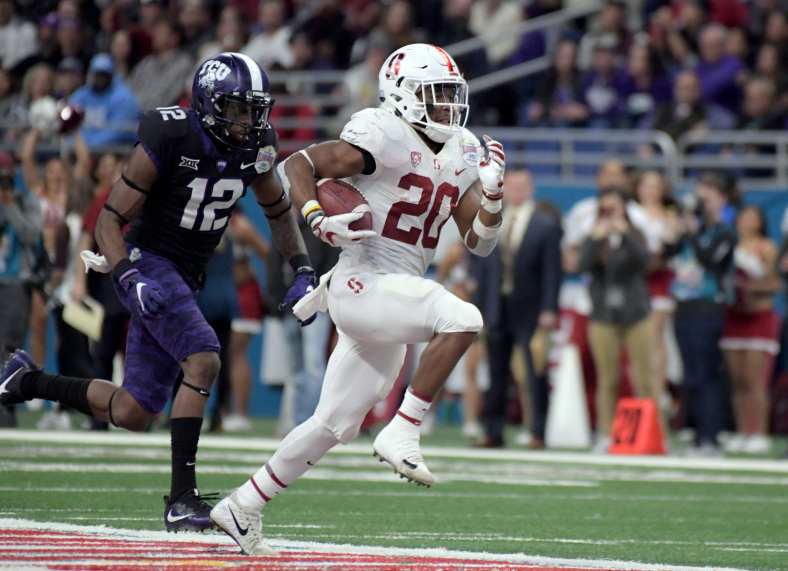
Only one running back has won the Heisman Trophy in the past eight years, but the 2018 college football season may well see another ball-carrier seize the most prestigious individual award.
Read on for a closer look at the top-flight backs who are among the top 15 in the game, including a couple who figure to be serious Heisman contenders.
Note: Stats and measurements courtesy of Sports Reference CFB.
15. Zack Moss, Utah
In his first year as a starter with the Utes, Moss acquitted himself extremely well. Not only did he run for 1,173 yards and 10 scores, he also hauled in 29 receptions for 243 more yards.
Moss showed a knack for stepping up in high-profile contests, too. He had 141 yards on the ground at USC, drove a blowout against UCLA with 153 rushing yards and two scores and had 150 yards on 20 carries and a touchdown in a bowl victory over West Virginia.
If Utah can put together a better passing offense in 2018, it’s only going to help Moss’ numbers improve.
14. Mike Weber, Ohio State
After posting a 1,000-yard season as a redshirt freshman in 2016, Weber was eclipsed on the depth chart by a true freshman in J.K. Dobbins. More on him later.
That doesn’t take away from the exceptional player Weber is, though. He greatly improved his yards per catch in his sophomore campaign and still ran for 10 touchdowns on only 101 carries.
Weber won’t see much more of a workload unless something unfortunate happens to the man in front of him in the backfield rotation. However, he’s still among the game’s elite backs and has a real chance at an NFL future.
13. Cam Akers, Florida State
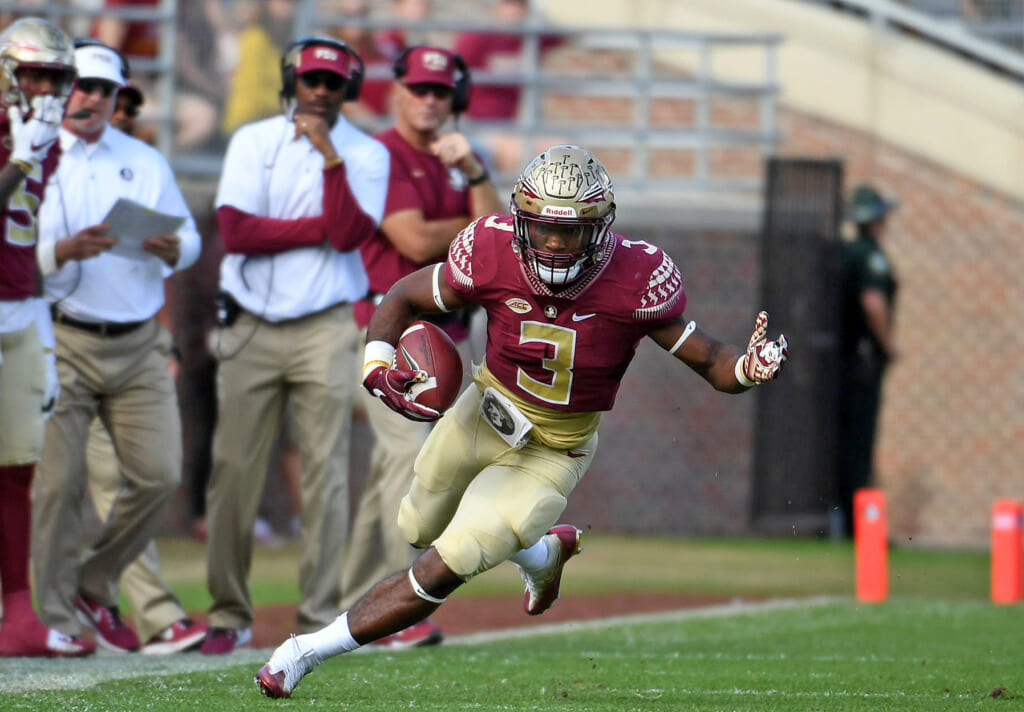
Big things are on the horizon for Akers, who was overshadowed by Wisconsin’s Jonathan Taylor as one of the country’s best first-year players in 2017.
Akers ran for a Seminoles freshman record 1,025 yards, eclipsing Dalvin Cook’s record. That’s pretty good company, and suggests Akers is ready to be the focal point of Florida State’s offense.
The 5-foot-11, 213-pounder shows great patience as a runner and has a noticeable initial burst that allows him to plow through defenders. With a year of experience under his belt, look for Akers’ yards per carry to significantly rise from 5.3.
12. AJ Dillon, Boston College
The Eagles wouldn’t have played in a bowl game last season if it wasn’t for Dillon’s immediate impact.
Dillon ran for 1,589 yards on 300 carries and 14 touchdowns in his maiden year on campus. His apex was a masterful, 272-yard, four-score effort against Louisville in a 45-42 victory.
One obvious area where Dillon has to improve is as a pass-catcher. He had exactly zero receptions in 2017 and must become a factor in that area of the game to boost himself further up the running back rankings.
11. Darrell Henderson, Memphis
Serving as more of a pass-catching specialist his freshman year, Henderson showed in 2017 he could do a lot with an increased workload in the running game.
The Tigers star ran for 1,154 yards (8.9 YPC) and added 24 receptions for 226 yards. Henderson should be an even bigger part of the 2018 offense with receiver Anthony Miller going to the NFL’s Chicago Bears.
A smaller sample size than most of the other top backs in the country keeps Henderson in the lower half of this list, as does the level of competition in the American Athletic Conference.
10. Justice Hill, Oklahoma State
The Cowboys are more frequently known as an explosive, pass-heavy offense, but Hill might change that identity at least for this upcoming season.
Star quarterback Mason Rudolph and receiver James Washington were both drafted by the Pittsburgh Steelers. That means Hill will have plenty of opportunities to shine on the college gridiron and boost his own NFL stock.
Hill ran for 1,467 yards and 15 touchdowns as a sophomore last year and nabbed 31 receptions. He’s so slippery in the open field, makes hard, decisive cuts and could easily rise in the running back hierarchy before season’s end.
9. D’Andre Swift, Georgia
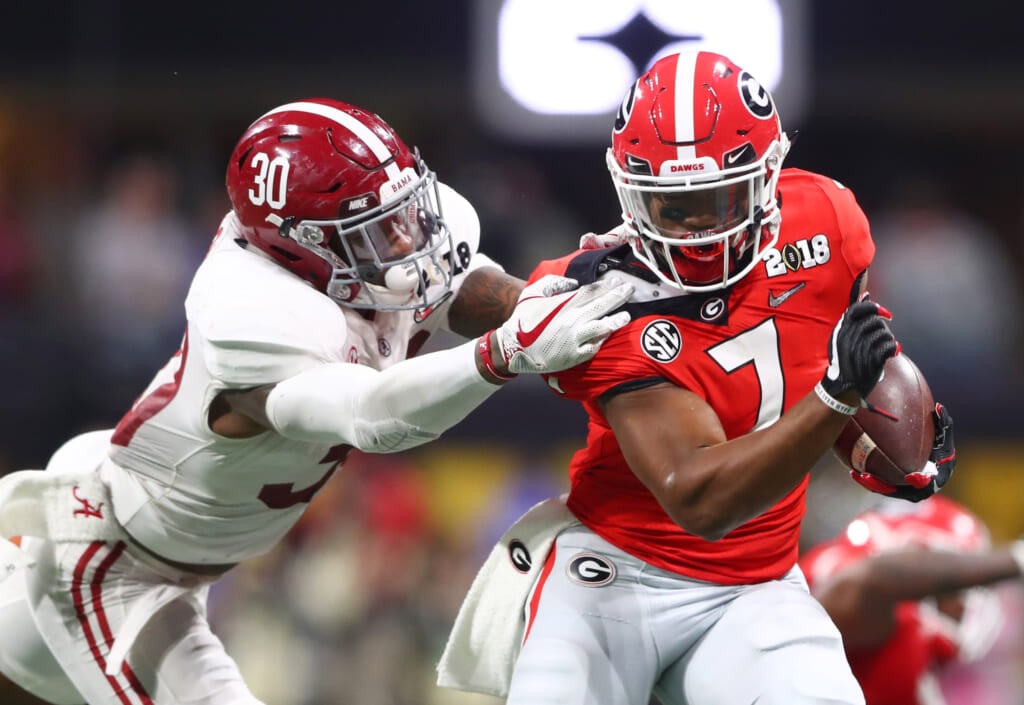
It’s rather bold to put someone who was a third-stringer last year this high, yet Swift is deserving of the spot.
Swift had more receptions in 2017 than high NFL draft picks Sony Michel and Nick Chubb combined for. He also averaged 7.6 yards per carry en route to 618 rushing yards.
The sophomore stud has blazing, easy speed, and a wide, thickly-built body to hold up to the pounding he’ll face as a feature back in the SEC. He’ll be a household name before long among college football fans.
8. Damien Harris, Alabama
The Crimson Tide always have a massive, physical offensive line, which makes the ball-carrier’s job easier. However, Harris’ talent is real, evident in his two straight 1,000-yard seasons at over seven yards per carry.
Now that Bo Scarbrough has moved on to the professional level, Harris steps in as the lead back for his senior season. An added bonus is that he should have the benefit of improved quarterback play with Tua Tagovailoa under center.
Harris could’ve left to the NFL draft after last season, but chose to return and should dominate more than he ever has in the lead role.
7. Devin Singletary, FAU
The numbers are mind-boggling when it comes to Singletary. In his first year under coach Lane Kiffin, Singletary was the driving force of a sensational rushing attack, scampering for 1,918 yards and a whopping 32 touchdowns.
Florida Atlantic won its final 10 games thanks largely to Singletary’s brilliance. Even before being introduced to Kiffin’s system, though, Singletary posted a 1,000-yard season as a freshman on 6.7 yards per carry.
Such a strong performance across two seasons in different offenses shows that Singletary is a great pure runner. He’ll have a prime chance to showcase his talents in the season opener against Oklahoma.
6. Benny Snell Jr., Kentucky
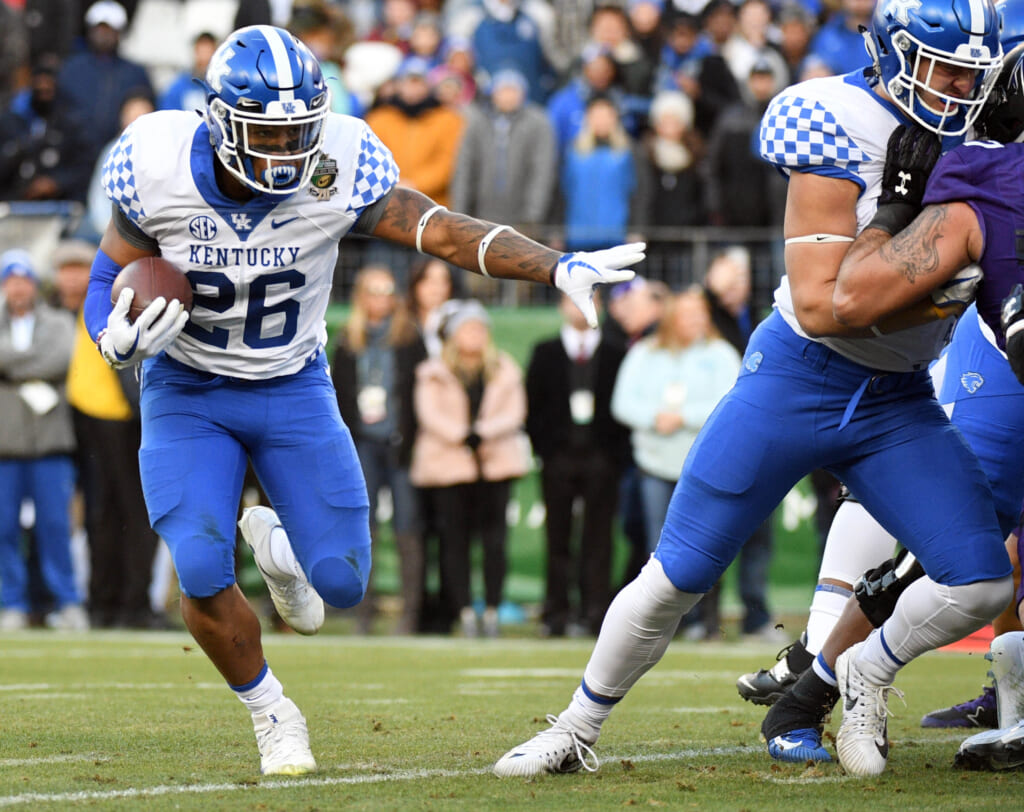
Context matters when it comes to Snell’s resume among the better running backs.
Kentucky finished 7-6 last season and 4-4 in the difficult SEC. Snell had four 100-yard rushing performances in conference games and a 94-yard outing against national runner-up Georgia.
Snell ran for 1,333 yards and 19 touchdowns in 2017 despite an underwhelming passing attack to support him. He defied the odds against loaded boxes and supreme SEC athletes for the majority of his games, and only figures to improve in his junior campaign.
5. Rodney Anderson, Oklahoma
Anyone can be dwarfed by the star power of Baker Mayfield, the reigning Heisman Trophy winner who led the Sooners to a College Football Playoff berth. Anderson was a dynamic back last season, though, who helped boost Mayfield’s passing numbers as well.
At 6’2″ and 218 pounds, it’s incredible how much explosiveness Anderson has to his game. He had 17 receptions for 281 yards (16.5-yard average) in 2017, along with 1,161 yards rushing and 13 scores.
Anderson stepped up when it mattered most in the playoff loss to Georgia, running for 201 yards and two touchdowns. That should be a sign of greater things to come as Oklahoma tries to fill the offensive void left by Mayfield, the NFL draft’s No. 1 overall pick.
4. J.K. Dobbins, Ohio State
It didn’t take long for the true freshman to explode onto the scene with the Buckeyes, as Dobbins ran for 181 yards in his college debut against Indiana.
Dobbins ultimately finished his first year in Columbus with 1,403 yards rushing and seven touchdowns, along with 22 catches, 135 yards and another score.
The factors threatening Dobbins’ run at a Heisman are slightly superior, more accomplished backs ahead of him, the strong precedent of quarterbacks and the scandal surrounding Urban Meyer.
Without the head coach’s influence and leadership, Ohio State’s 2018 outlook is difficult to project, particularly with a new quarterback in Dwayne Haskins taking over the offense.
3. Myles Gaskin, Washington
No college running back is better established than Gaskin, who’s been a three-year starter for the Huskies and run for over 1,300 yards in each of those seasons.
Gaskin had 21 of his 45 rushing touchdowns as a junior. Apparently he’s as deliberate with his decision to join the NFL as he is as a runner on the field.
Tacklers bounce off Gaskin with ease; he has deceptive breakaway speed to go with that power and shows soft hands when he catches the ball. All those skills suggest yet another monster season for Gaskin in 2018 to end an epic collegiate career in style.
2. Jonathan Taylor, Wisconsin
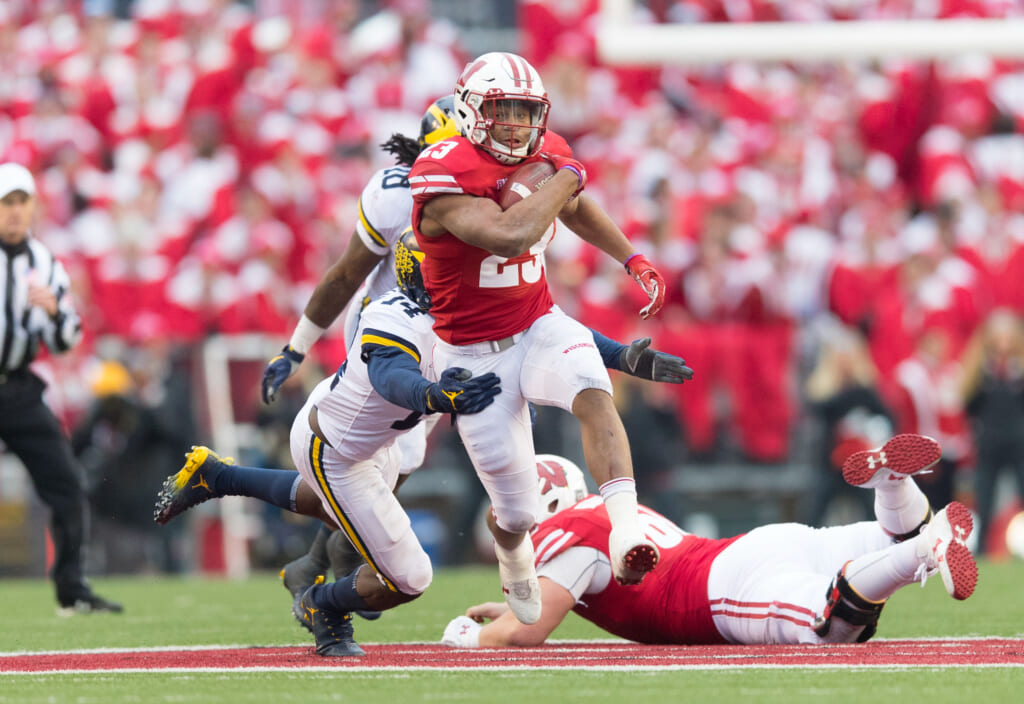
Impressive as Akers and Dobbins were as freshmen last season, no one made a bigger splash than Taylor, who had three games of 200-plus rushing yards and route to 1,977 yards on the ground and 19 touchdowns.
Taylor has the benefit of running behind a bruising Badgers line that regularly deploys, big blockers who love to get downhill and deliver crushing blocks. Wisconsin’s prodigious ball-carrier brings plenty of physicality between the tackles to fit that style well.
It’s hard enough for opponents to get to Taylor when he has such a great offensive line at his disposal. The fact he’s so powerful, elusive and explosive makes him one of the premier skill players in college football.
1. Bryce Love, Stanford
The Heisman runner-up from a season ago returns to the Cardinal for his senior season. Love ran for 2,118 yards in 2017 on 8.1 yards per carry and 19 touchdowns.
That proficiency as a runner didn’t result in Love taking on such a heavy workload as other backs who run for that much yardage. It should allow him to enter the 2018 campaign fresh and read to handle even more touches.
To be that dynamic and explosive despite the defense knowing he was the primary threat shows how special Love is — and why he’s the best at his position in the nation.